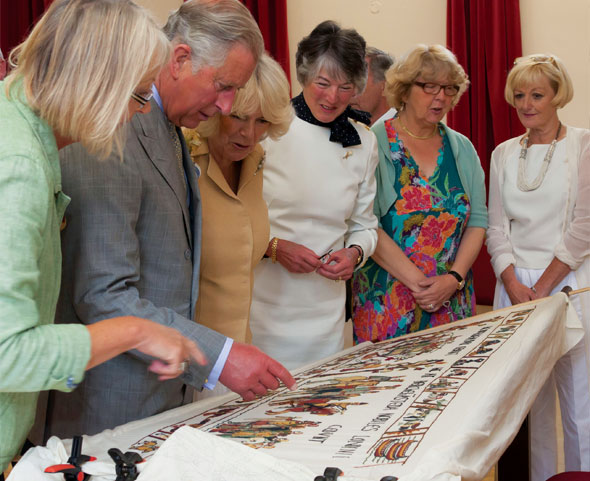Move over, Bayeux
The Bayeux Tapestry is an embroidered linen cloth 70 metres (230 feet) long, probably sewn in England in the 1070s as Norman propaganda. Kate Russell, an American who lives on Alderney, says that for years she was obsessed with the thousand-yearold artwork, embroidering scenes from the original and researching it. ‘Many experts agree that part of the tapestry is missing, because it ends on the battlefield of Hastings rather than with William the Conqueror’s coronation in London on Christmas Day 1066.’
 From left: Kate Russell with the Duchess of Cornwall. American-born Kate Russell, who originated the project. The design for the tapestry, created by local artist Pauline Black
From left: Kate Russell with the Duchess of Cornwall. American-born Kate Russell, who originated the project. The design for the tapestry, created by local artist Pauline Black Inspired by The Bayeux Tapestry Embroiderers’ Story by Jan Messent, a practical account of how the tapestry was created, she decided to establish a community project on Alderney, to make a sequel to the tapestry with the help of a £300 grant from the Alderney States. ‘The Alderney Bayeux Tapestry Finale is historically accurate in style, content and materials,’ she explains, ‘but it isn’t a copy of the original. It extends the story to its logical conclusion with William crowned at Westminster Abbey.’
 From top left: Prince Charles and the Duchess of Cornwall add stitches to the tapestry.Discussing the tapestry. The tapestry arrives at the Bayeux Tapestry Museum
From top left: Prince Charles and the Duchess of Cornwall add stitches to the tapestry.Discussing the tapestry. The tapestry arrives at the Bayeux Tapestry Museum Alderney, just three miles by oneand- a-half with a population of under 2,000, drew on island talent to create the tapestry. Pauline Black, a local artist, designed the template for the tapestry, consulting Jan Messent’s book for the correct style and colours. The Alderney version, like the Bayeux original, features a series of Latin captions describing the story. These were written by Robin Whicker, a retired schoolteacher who says the task proved an interesting learning curve. ‘I realised that the Normans wrote Latin using the modern English word order, demonstrating that the language was in a stage of transition.’
In February 2012 a 10ft section of framed linen was installed in Alderney’s library. When the library was open, embroiderers could be found absorbed in stitching the tapestry, with its Norman knights, Anglo- Saxon peasants and bloody battle scenes. Some were experienced at needlework, but many had picked up a needle for the first time. Age was no barrier – embroiderers ranged in age from four-year-olds to a 90-something enthusiast, and visitors to the island from as far afield as Australia and the US also became involved.

The project even received the royal stitch of approval when Prince Charles and the Duchess of Cornwall sewed a section of the tapestry during their official Jubilee visit to Alderney in 2012. The tapestry includes references to the Channel Islands, with a toad symbolising Jersey, a donkey representing Guernsey and the Alderney puffin encircled by the tail of the English lion, showing that William I, who was Duke of Normandy, brought the Channel Islands under the English crown. Even today in the Channel Islands Elizabeth II is known as the Duke of Normandy, and during their visit Charles and Camilla were presented with a miniature embroidery of the Channel Island animals protected by the English lion.
 The third scenes of the tapestry, depicting William at his coronation
The third scenes of the tapestry, depicting William at his coronationThe Alderney Tapestry became a focus for the community, with many people visiting regularly. Moira Sleeman runs a B&B on the island and went to the library to do a feature for Radio Guernsey. She tried a few stitches and was hooked: ‘I returned every day; it was so relaxing sitting round the stitching frame with people who might not otherwise meet.’
Contrary to the belief that sewing is for sissies, many husbands, fathers, boyfriends and sons queued up to contribute to the project. With the Norman Conquest on the curriculum, the local school used the tapestry as a valuable teaching aid, and pupils paid regular visits to see its progress. One 10-year-old boy admitted, ‘Sewing isn’t my thing, but I enjoyed seeing all the gory bits in the tapestry with arms and legs everywhere. It’s like a cartoon.’
 The first scene of the tapestry, depicting William dining after the Battle of Hastings
The first scene of the tapestry, depicting William dining after the Battle of HastingsOne year from its inception the tapestry was completed, and in April 2013 the curator of the Bayeux Tapestry Museum and other French dignitaries visited Alderney to unveil it. They were so impressed that they invited Kate Russell to bring it to Bayeux to be exhibited there in 2014.
 Prince Charles and the Duchess of Cornwall study the tapestry
Prince Charles and the Duchess of Cornwall study the tapestryThe Alderney Tapestry is now on permanent display in Alderney Library, and next month it will once again be in the spotlight during the first Alderney Literary Festival. With the theme of ‘History: Fact and Fiction’, the four-day event has attracted some of the UK’s most eminent historians and historical-fiction writers. A distinguished panel including Carol McGrath, author of The Handfasted Wife, and Marc Morris, presenter of the Channel 4 series Castle, will discuss ‘The Bayeux Tapestry: Embroidering the Facts of History’. Kate Russell will also be there, speaking for all those embroiderers who created Alderney’s remarkable postscript to the Battle of Hastings.
The Alderney Literary Festival runs from 19 to 22 March: www.alderneyliterarytrust.com and www.alderneybayeuxtapestry.com



